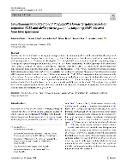Simultaneous PCR detection of Paenibacillus larvae targeting insertion sequence IS256 and Melissococcus plutonius targeting pMP1 plasmid from hive specimens

Author
Vlková, Kateřina
Kamler, Martin
Publication date
2024Published in
Folia MicrobiologicaVolume / Issue
69 (2)ISBN / ISSN
ISSN: 0015-5632Funding Information
MZE/QK/QK1710228
MSM//LX22NPO5103
Metadata
Show full item recordCollections
This publication has a published version with DOI 10.1007/s12223-023-01125-0
Abstract
Paenibacillus larvae and Melissococcus plutonius represent the most threatening bacterial diseases of honeybee (Apis mellifera)-American and European foulbrood, respectively. For efficient control of those diseases, rapid and accurate detection of the pathogens is crucial. Therefore, we developed a novel multiplex PCR method simultaneously detecting both pathogens. To design and optimize multiplex PCR reaction, four strains of P. larvae representing four ERIC genotypes I-IV (strain DSM 7030-ERIC I, DSM 25430-ERIC II, LMG 16252-ERIC III, DSM 3615-ERIC IV) were selected. Those strains were fully sequenced using long-read sequencing (Sequel I, Pacific Biosciences). For P. larvae, the multicopy insertion sequence IS256 identified in all genotypes of P. larvae was selected to provide high sensitivity. M. plutonius was detected by plasmid pMP1 sequence and the virulence verified by following detection of ETX/MTX2 toxin responsible for pore formation in the cell membrane. As an internal control, a gene encoding for major royal jelly protein 1 specific for honeybees was selected. The method was validated on 36 clinical specimens collected from the colonies suffering from American and European foulbrood in the Czech Republic. Based on the results, sensitivity of PCR was calculated to 93.75% and specificity to 100% for P. larvae diagnosed from hive debris and 100% sensitivity and specificity for honeybee workers and larval scales as well as for diseased brood infected by M. plutonius.
Keywords
American foulbrood, Apis mellifera, European foulbrood, Melissococcus plutonius, Multiplex PCR, Paenibacillus larvae.
Permanent link
https://hdl.handle.net/20.500.14178/2414License
Full text of this result is licensed under: Creative Commons Uveďte původ 4.0 International







